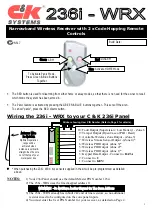
CIRCUIT DESCRTPTION
1) Receiver System
1. Front End
The signal from the antenna is passed through a low-pass filter and input to
the voltage step up circuit consisting Of L14. The signal from L14 is led to
the gate of Q1. D19 is the diode limiter circuit against the excessive input
power of more than 20dBm. Q1 is the FETwhich has two gates. The
voltage of the gate 2 is set higher to get the high gain and sensitivity. The
signal from Q1 is led to the triple band pass filter (L4, L5, L6), and gets the
high image rejection ratio.
2. Mixer Circuit
The signal from the triple band pass filter is converted into the first IF signal
of 17.2MHz. The receiving signal is led to the gate 1 of Q2, and the first
local oscillator signal is led to the gate 2 of Q2. To get the high conversion
gain, the local oscillator signal voltage is set to about 1V. To reduce the
high adjacent channel interference, the band width of the FL2 is set to
20kHz. The signal from FL2 is amplified by Q8, and input to FM IF system
IC3 of TK10487.
3. IF Circuit
The TK10487 has the second local oscilltor circuit, mixer circuit, detector
circuit, squelch circuit, and so on. Pin1 and 2 are the terminals of the crystal
oscillator circuit. Pin2 (emitter) is connected to the ground via the resister
R3 to prevent the oscillator from decreasing the power at the low tempera-
ture. Pin4 of IC3 is connected to FL1 directly because the matching resistor
for ceramic filter is built-in. The quadrature circuit (pin10 of IC3) is con-
nected to the ceramic resonator X2 for the temperature stability and good
quality. The signal from pin11 of IC3 is connected to the LPF. The detected
AF signal, which has flat frequency characteristics, is led to the control unit
and used as both squelch signal and tone squelch signal. De-emphasis
circuit consists of R31, R32, C26 and C27. The LPF amplifier consisting of
Q5 and Q6 is located far away from the VR in the control unit, so it outputs
the high voltage signal to prevent S/N from the deterioration. The squelch
switch circuit consists of Q4 and Q16, and switches on/off at the point where
there is no voltage to prevent from the switching noise. The S meter signal
from pin12 of IC3 is led to the CPU in the control unit after adjusting the level
at D20 and VR5. The S meter signal is thermal compensated by TH1 and
stabilized. The noise amplifier consists of pin13 and 14, the built-in OP
amplifier in IC3. The output signal of noise amplifier is amplified by Q14,
rectified by D5, and then led to the pin15 (hysteresis comparator input) of
IC3.
4. AF Circuit
IC4 is about 5W audio power amplifier IC. When the capacity of pin1 in C16
is increased more, the output incidental noise becomes smaller. The high-
pitched tone becomes smaller at the same time, This radio's capacity of
C16 is determined considering the high-pitched tone.
PAGE-3
Содержание DR-M03SX
Страница 7: ......
Страница 8: ......
Страница 9: ......
Страница 10: ......
Страница 11: ......
Страница 12: ......
Страница 13: ...11 M57735 XA0271 50 54MHz RF Power Module Page 14 ...
Страница 14: ......
Страница 15: ......
Страница 16: ......
Страница 17: ......
Страница 18: ...ES0017 KZ0047AZ KS0041CZ FF0031 FF0028 ...
Страница 19: ...KZ0012 DRM06 KZ0025 DRM03 AD0010 DRM06TH AB0011 DRM03SX ...
Страница 20: ...DR M03SX AB0011 L502 QR0112 L501 QR0018 C504 103 C501 C502 C503 2SC3133 Q501 UP0255A Page 20 1 ...
Страница 29: ...DRM06 MAIN Unit Page 32 1 ...
Страница 30: ...DRM06 MAIN Unit 39P Page 32 2 ...
Страница 31: ...DRM03 MAIN Unit Page 33 1 ...
Страница 32: ...DRM03 MAIN Unit Page 33 2 ...
Страница 33: ...DRM06 DR03 CPU unit Page 34 1 ...
Страница 34: ...DRM06 DR03 CPU unit Page 34 2 ...
Страница 37: ...PC BOARD VIEW 1 3 Main Unit Side A Page 35 3 ...
Страница 39: ...3 CPU Unit Side A 4 CPU Unit Side B Page 37 1 R223 ...
Страница 40: ...3 1 CPU Unit Side A 4 2 CPU Unit Side B Page 37 2 R244 R243 S202 S203 R242 R241 R287 ...




































